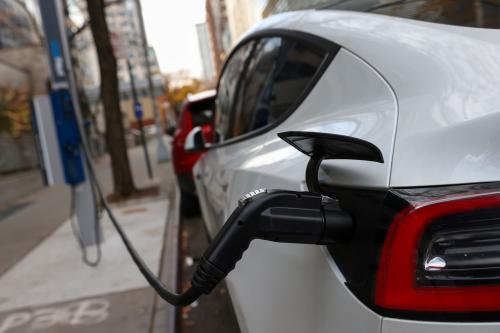Content from the Brookings-Tsinghua Public Policy Center is now archived. Since October 1, 2020, Brookings has maintained a limited partnership with Tsinghua University School of Public Policy and Management that is intended to facilitate jointly organized dialogues, meetings, and/or events.
Renewable energy is an important source to tackle against climate change, as the latest IPCC report has pointed out. However, due to the existence of multiple market failures such as negative externalities of fossil fuels and knowledge spillovers of new technology, government subsidies are still needed to develop renewable energy, such as solar photovoltaic (PV) cells. In the United States, there have been various forms of subsidies for PV, varying from the federal level to the state level, and from the city level to the utility level. California, as the pioneer of solar PV development, has put forward the biggest state-level subsidy program for PV, the California Solar Initiative (CSI). The CSI has planned to spend around $2.2 Billion in 2007–2016 to install roughly 2 GW PV capacity, with the average subsidy level as high as $1.1/W. How to evaluate the cost-effectiveness and incentive pass-through of this program are the two major research questions we are pursing.
Our cost-effectiveness analysis is based on a constrained optimization model that we developed, where the objective is to install as much PV capacity as possible under a fixed budget constraint. Both the analytical and computational results suggest that due to a strong peer effect and the learning-by-doing effect, one can shift subsides from later periods to early periods so that the final PV installed capacity can be increased by 8.1% (or 32 MW). However, if the decision-maker has other policy objectives or constraints in mind, such as maintaining the policy certainty, then, the optimally calculated subsidy policy would look like the CSI.
As to the incentive pass-through question, we took a structural approach and in addition used the method of regression discontinuity (RD). While in general, the incentive pass-through rate depends on the curvature of the demand and supply curve and the level of market competition, our two estimations indicate that the incentive pass-through for the CSI program is almost complete. In other words, almost all of the incentive has been enjoyed by the customer, and the PV installers did not retain much. Based on the RD design, we observe that PV installers tend to consider the CSI incentive as exogenous to their pricing decision.
The relative good performance of the CSI in terms of both the cost-effectiveness and the incentive pass-through aspect are tightly related to its policy design and program management. International speaking, the biggest challenge for the design of any PV subsidy program is the quick running out of the budget, and in the end, it looks like customers are rushing for the subsidy. Such rushing behavior is a clear indication of higher-than-needed incentive levels. Due to the policy rigidity and rapid PV technological change, the PV subsidy policy may lag behind the PV cost decline; and as a result, rational customers could rush for any unnecessarily high subsidy.
Due to the high uncertainty and unpredictability of future PV costs, the CSI put forward a new design that links the incentive level change and the installed capacity goal fulfillment. Specifically, the CSI has designed nine steps to achieve its policy goal; at each step, there is a PV capacity goal that corresponds to an incentive level. Once the capacity goal is finished, the incentive level will decrease to the next lower level. Furthermore, to maintain the policy certainty, the CSI regulated that every step-wise change in the incentive level should not be higher than $0.45/W, nor smaller than $0.05/W, together with other three constraints.
A good subsidy policy not only requires flexible policy design to respond to fast-changing environment, but also demands an efficient program management system, digitalized if possible. For the CSI, the authority has contracted out a third-party to maintain a good database system for the program. Specifically, the database has documented in detail every PV system that customers requested. Key data fields include 22 important dates during the PV installation process, customers’ zip code, city, utility and county information, and various characteristics of the PV system such as price, system size, incentive, PV module and installer. All information is publicly available, which to some extent fills in the information gap held by customers and fosters the market competition among PV installers. For customers to receive the incentive, their PV systems have to pass the inspection of the local government, and also to be interconnected to the grid. On the supply side, the CSI has also certified and created a list of PV installers that every customer can choose from.
Although the CSI has ended in 2014 due to fast PV cost reduction starting from 2009, its experience has been transferred to other areas in the United States and in Europe. It is highly possible that other similar new technologies and products (e.g. the electric car and the battery) can adopt the CSI policy design, too. In summary, a good and successful policy may need to be simply, clear, credible, foreseeable, flexible, end-able, and incentive-compatible. The PV subsidy policy in China still has a long way to go when compared to the CSI.



Commentary
Optimal solar subsidy policy design and incentive pass-through evaluation: using US California as an example
July 4, 2016